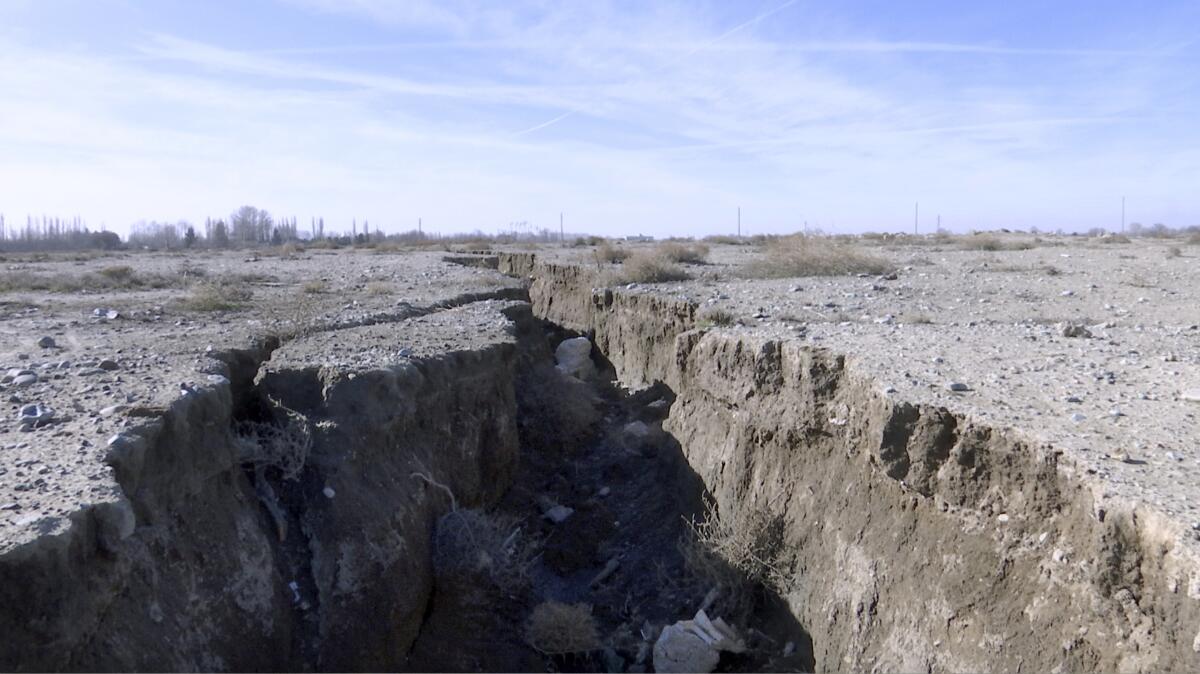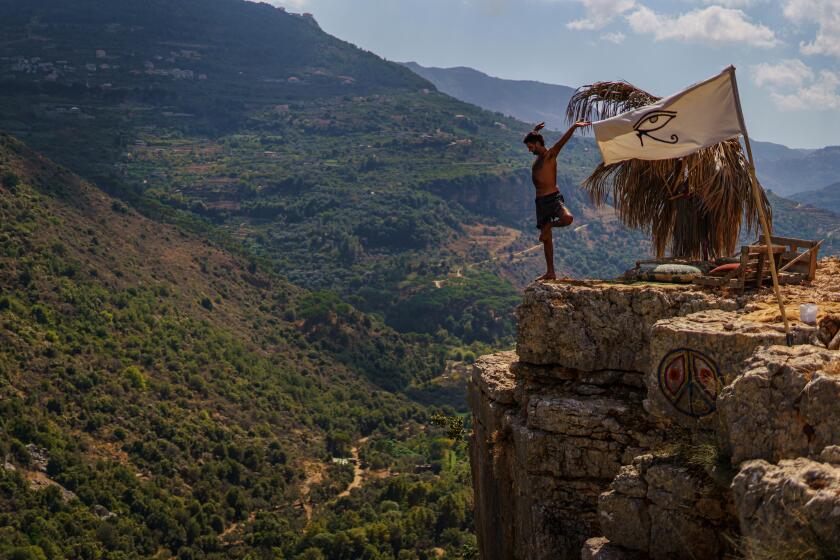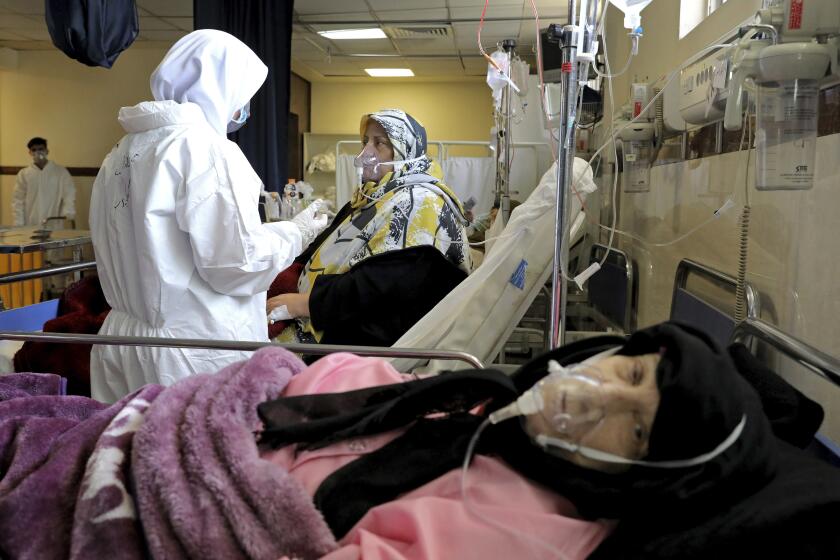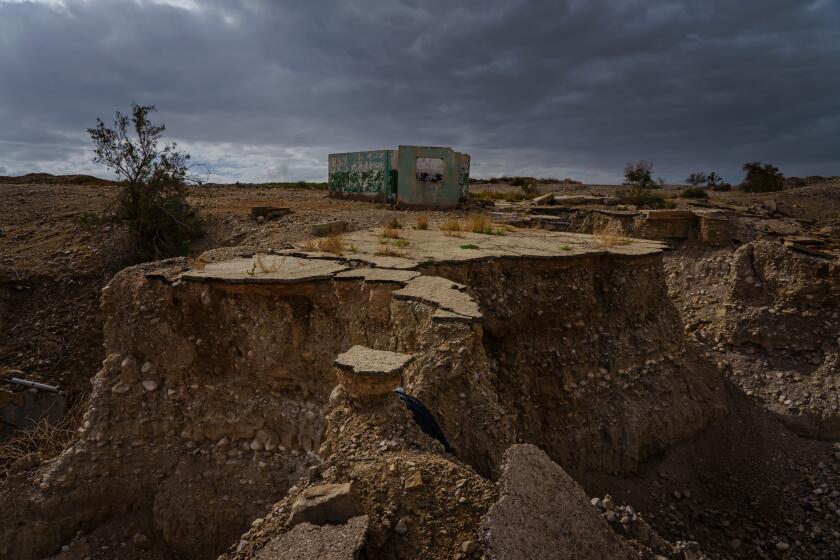As water table lowers, Tehran and much of Iran are slowly sinking

- Share via
TEHRAN — Pari Rahmanian and her daughters were sitting down to dinner in her brother’s third-floor apartment in south Tehran when the ground began to move.
“There was just this rumbling sound. I raced to my daughters to get them out. I was sure it was an earthquake,” Rahmanian, 47, said. When she got to the hallway she realized what actually was happening: The building was settling in shifting soil.
“I’ve never seen anything like that before,” Rahmanian said of the structure, which authorities deemed unsafe to reenter. “It’s no joke. You lose everything you have in seconds.”
The Rahmanian family had become victims last winter of land subsidence — the sudden sinking of the ground, usually due to water depletion — a growing crisis threatening Tehran’s 13 million residents and, increasingly, a problem across Iran, experts say.
Officials and outside experts have long linked subsidence in Tehran to over-extraction of groundwater, with the falling water levels causing the soil to shift and settle in many neighborhoods and at the airport.
“The disaster is rooted in the fact that 4 billion cubic meters of water are annually extracted from 50,000 wells, a third of which are illegal,” Mohsen Tabatabei, an official with the Ministry of Roads and Urban Development, told local reporters in June.
The government says a dam is necessary to provide drinking water in an era of rising temperatures and climate change. Activists say it’s another corrupt government project.
“We’re seeing it [subsidence] in 30 out of the 31 provinces. Most major plains, let’s say 450 of 609, are in critical condition,” Mostafa Fadaeifard, who heads flood assessment operations at the Iranian National Committee on Large Dams, said in an interview.
The problem is particularly acute in the capital and its environs, said Alireza Shahidi, director of Iran’s Geographical Survey and Mineral Exploration.
“In some countries, one inch of subsidence is considered a catastrophe,” Shahidi said in a May interview with the state-run Iranian Students News Agency. “Unfortunately, we have recorded ... 14 inches in the Greater Tehran region.”
By comparison, in Florida’s Surfside, where a condo collapse killed 98 people in late June, scientists put the subsidence rate at 0.08 inches. (Subsidence is thought to be one of the contributing factors to the tragedy.)
The spike in subsidence here has accompanied a sharp increase in water scarcity, itself a result of climate change as well as a poorly maintained water management system.
“We’ve lost 30% of renewable water resources over the last four decades, meaning 35 to 40 billion cubic meters,” Fadaeifard said.
In June, the National Water & Sewage Co. classified some 210 cities as “water stressed.”
“This phenomenon will swallow people’s houses, lands and the country’s infrastructure,” Fadaeifard said.
Hit by pandemic exhaustion and plummeting incomes, Iran’s healthcare professionals are emigrating in big numbers when the country can least afford it.
For months now, protests over escalating water and power shortages have erupted in Khuzestan, the oil-rich province in the country’s southwest where temperatures regularly top 123 degrees. Khuzestan is known for its rivers, but many are now drying out due to climate change and overuse.
Similar demonstrations mushroomed all over the country in recent days, often spurring a deadly response from the government, activist groups claim. Amnesty International said security personnel used live ammunition, killing at least eight people in seven cities between July 15 and 23.
With conditions increasingly untenable, those who can afford it are escaping Iran’s hotter provinces to more temperate areas by the Caspian Sea in the north; others have emigrated to Turkey, adding to the eight-fold increase in the last two years of Iranians purchasing property there.
“Thousands of people, especially from Isfahan, have flocked to the north,” said Moqaddam, a real estate agent based in the resort city of Kelardasht, a stone’s throw from Iran’s northern shore on the Caspian. He gave only his last name for reasons of privacy.
“The price of land has quadrupled here,” he said, adding that illegal deforestation had also increased so developers could build more housing.
Climate change means Jordanians may soon not have enough water to drink. Others will face a similar scarcity.
The backdrop to the crisis is four decades of Iran’s hostility with the U.S., and the devastating effect of Washington’s sanctions on the country’s economy. With fears of all-out war on their mind, senior officials at the highest levels of government aimed for self-sufficiency, driving a massive food security program that has exhausted underground water resources in this arid country.
The massive agricultural expansion has resulted in roughly 90% of Iran’s total water consumption being used for agricultural purposes. Around 80% of that is drawn from underground aquifers, depleting them at a rate many times over the world average, officials say. Many have turned to illegal wells, with some 30,000 in the capital alone.
Sanctions exacerbated an already bad situation, crippling investment in modernizing the agricultural sector, even as the government pushed more people into farming as the cheapest, easiest way to create jobs for a besieged economy; a “suicidal mistake,” said Jaber Khadivi, an engineer and head of an irrigation-systems startup.
“Unstable agricultural development has been a lurking issue for many years, but its mushrooming effect has surprised officials today,” Khadivi said. “The government has long ignored the fact that Iran’s arid climate and poorly efficient farming sector cannot fit in 5 or 6 million farmers.”
Khadivi also blamed authorities for failing to invest in desalination plants, an integrated cloud-seeding program or smart valves that can measure excessive or illegal water consumption. Instead, the government has doubled down on water management strategies that ignore the country’s changing realities.
Over the last 40 years, for example, authorities have built dozens of dams — Iran now has some 192 of them — to mitigate water shortages. But in the desert climate, a lot of that water evaporates.
Toward a more sustainable California
Get Boiling Point, our newsletter exploring climate change, energy and the environment, and become part of the conversation — and the solution.
You may occasionally receive promotional content from the Los Angeles Times.
The problem is likely to get worse, with projections that temperatures will rise by more than 4 degrees over the next 40 years while precipitation falls by around 35%.
For people whose property is damaged by subsidence, there is little option but to move. That’s what happened to Rahmanian’s brother; Tehran city officials evacuated all 10 families in the apartment building and demolished it.
Many other cases go unreported, with owners reluctant to inform authorities so as to avoid having their property torn down.
In 2019, horrible cracks began to appear in the office of Ahmad Reza, a 52-year-old business manager in a one-story building along the capital’s main shopping thoroughfare.
“Our building had slanted a few inches westward,” he said.
Authorities announced subway construction had damaged some structures in the neighborhood. Reza called a government friend who said subsidence could have also been a cause. Pursuing the issue further could have resulted in the building being torn down.
“I didn’t want that happen so I resorted to a private company to fix it.”
So far, the repairs have held up, he said.
“It hasn’t got worse for two years now,” he said. “I have my fingers crossed.”
Special correspondent Khazani reported from Tehran and staff writer Bulos from Beirut.
More to Read
Sign up for Essential California
The most important California stories and recommendations in your inbox every morning.
You may occasionally receive promotional content from the Los Angeles Times.













